LOS ANGELES – When expansion side LAFC announced in May 2015 that they’d selected a site for their new stadium, they had no coach, players, colors or even a crest.
This was a time before their black and gold snapback became one of MLS’s most-lauded accessories.
Yet there was a sense that spring day, on an unassuming grass median beside the Los Angeles Memorial Sports Arena, that if the club could build the first open-air stadium in Los Angeles proper since 1962, then everything else might just fall into place.
Down the street from the Staples Center, across the street from USC, accessible by train and two major freeways, the Sports Arena site was more than ideal — it was perfect.
By August of 2016, the iconic arena had fallen and LAFC co-owners Will Ferrell and Magic Johnson worked the levers of heavy machinery to break ground for the club’s home.
While Wednesday marked the official ribbon-cutting for the completed Banc of California Stadium, several key elements are still receiving finishing touches ahead of Sunday’s home opener against Seattle (9 pm ET; FS1 — Full TV & streaming info). In the meantime, MLSsoccer.com was given an exclusive tour of the stadium in its entirety and found 10 features for future visitors to take an early peek at.
Key to the city
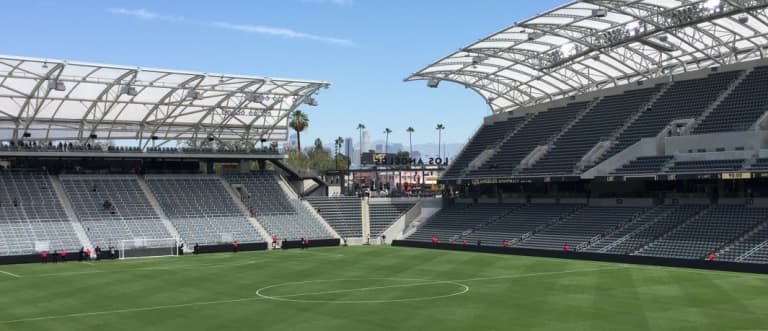
Banc of California Stadium's keyhole feature | photo by Alex Dwyer
Inspired by executive chairman and co-owner Peter Guber’s vision, a northeast slice of the stadium has been carved away to capture the downtown Los Angeles skyline and the San Gabriel Mountains behind in – a perfect frame.
In a city famous for its urban sprawl, it’s a visual reminder of the stadium’s inclusion in LA’s growing urban core. Though the entire southwest corner of Banc of California is gifted the view, members of the media in the venue’s angled press box have one of the best vantage points to peer through the keyhole.
3252 North End

Safe standing in the North End | photo by Alex Dwyer
Across MLS, clubs are doing their part to give supporters a platform to express themselves. Banc of California Stadium is no exception. The ground’s North End is home to the 3252 independent supporters’ union and their “safe standing” section. Among the league’s steepest at 34 degrees, the stand’s angled handrails were designed to provide a less encumbered support experience. In practice, the curved guard rails are reminiscent of gripping the safety bar when you’re strapped into a roller coaster.
The central section of the stand is an actual removable stage — something built in to allow the stadium to play a role beyond regular MLS matchdays for concerts and events (the first of which, Wango Tango, will take place June 2). Both owners and architects spoke to the stadium’s function not just as a soccer stadium, but a cultural hub.
Capping off The North End is a supporter-designed bar to be officially unveiled later this week with members of the 3252.
For the people
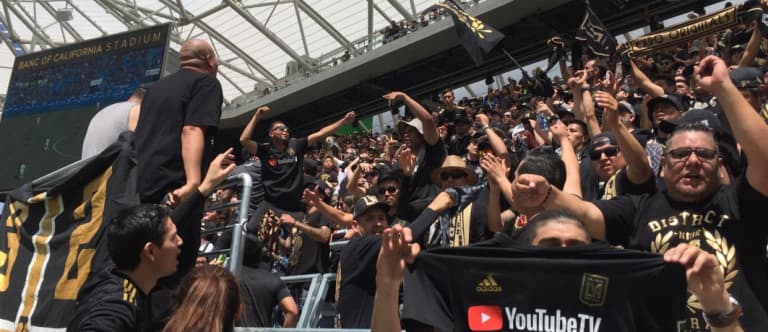
LAFC fans check out the 3252 section | photo by Alex Dwyer
For all the glitz elsewhere, $20 seats in the supporters section invite local participation.
In a sense, the 5 million pounds of steel and 190,000 square feet of ETFE roofing that comprise the meat of the structure is only the skin laid atop the heartbeat of the stadium: the people in the south Los Angeles community.
“It might be the only stadium in America that, right across the street, is affordable housing,” co-owner Magic Johnson said ahead of Saturday’s open house. “That means everybody gets to participate.”
Though the stadium also achieved LEED Silver status for its environmentally conscious construction, it’s the more than $7 million in total annual revenue for the city/county and the several thousand jobs that make the stadium itself the metaphorical manifestation of the club’s “street by street, block by block” approach.
Gear up
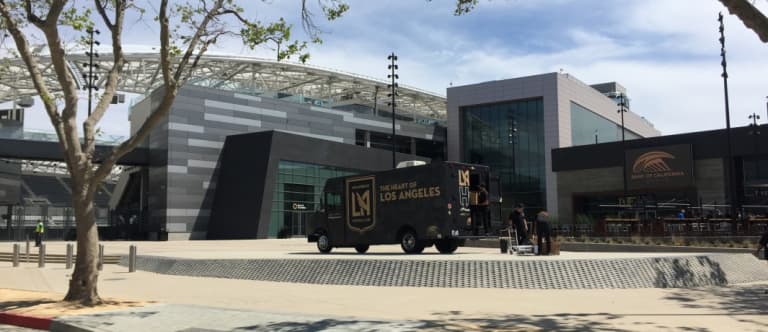
One of LAFC's merch trucks at the stadium | photo by Alex Dwyer
Buying merchandise at a professional sports venue is about as exhilarating an experience as sliding your finger across a phone screen — which is perhaps why so many people buy their club gear online these days. To their credit, LAFC has tried to reimagine swag acquisition in their designing of the stadium.
LAFC have two gear outposts in the stadium concourse — designed using the same shipping container architecture as the club’s new training facility — as well as two of the city’s quintessential food trucks converted to sell merch, which have been roaming the city for some time and will be parked at the stadium occasionally.
The flagship store sits outside the gates of the stadium in an auxiliary building that will also feature two beer gardens (one on the roof and another adjacent) as well as a high-concept restaurant to be opened later this summer. The store features a massive mural of 3252 supporters and ample rack space, where the club may take a cue from the clothing boutiques of city and offer exclusive offline-only gear in an environment that’s as much experience as commerce.
Hidden room

The owners-only hidden room in the Director's Lounge | photo by Alex Dwyer
From its foundation, LAFC’s varied A-list ownership group has distinguished the club not only from other teams in MLS but among sports organizations around the world. These owners range from NBA legends, MLB All-Stars, and World Cup winners to founders of YouTube, creators of video game League of Legends and, yes, Will Ferrell.
Numbering over 30 members, this group had plenty to say in the design of the stadium — the $350 million venue was privately funded, after all — and one space more than any other attests to this.
Inside the exclusive, gold-accented Director’s Lounge, where only owners and their guests have access, is yet a further tier of exclusivity. In fact, this room is so exclusive, it’s hidden to the naked eye. Push one wall the right way, however, and a door creaks open to a space featuring several chairs, a couch and a panel of private lockboxes.
One can only imagine the conversations that will take place there in the years to come.
Bunker breakaway
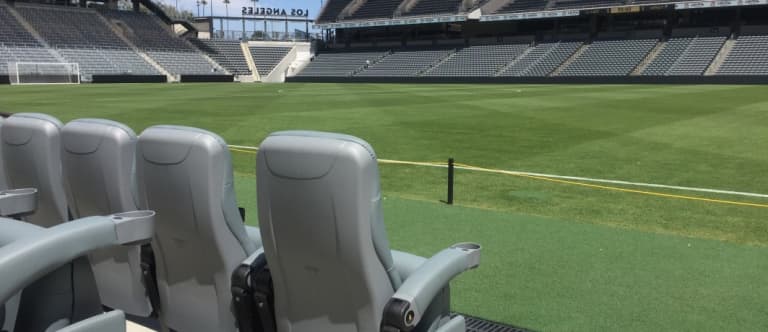
A view from the Field Level suites | photo by Alex Dwyer
Among the 33 suites in the building, only one third of them — the “Field Level” — possess the ability to actually put feet on the grass. Those seats are immediately beside the visiting and home benches, essentially pitchside.
The highest-entry club available to the public, these fortunate individuals also have exclusive access to the player tunnel and a vaulted ceiling food/beverage area that was described to me by one supporter who found its fancifulness to be “something I’d imagine seeing in Dubai or Abu Dhabi.”
But it’s the third space in the “Field Level” that re-imagines private matchday luxury. Referred to during the construction phase as “Bunker Suites,” these spaces are essentially boxes directly beneath seats where members can easily duck into through their personal entrances whenever they feel like taking a break from the action.
Business-first changing room
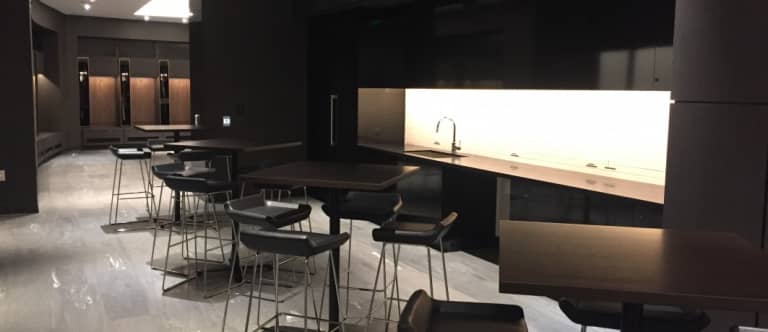
A glimpse of the locker rooms | photo by Alex Dwyer
LAFC spared few expenses in their cushy treatment for season-ticket holders and extended that kindness to players. Everything from the magnetic compartmentalized lockers to the giant hydrotherapy baths in the changing room is evidence of the club’s concern for the employees whose work is the most scrutinized.
The home team's dressing room is a departure from the shapelier locker rooms at the club’s training facility, a difference architecture firm Gensler’s design director Steve Chung summed up by explaining that at the stadium the players are "expected to be all business.”
A tunnel vision
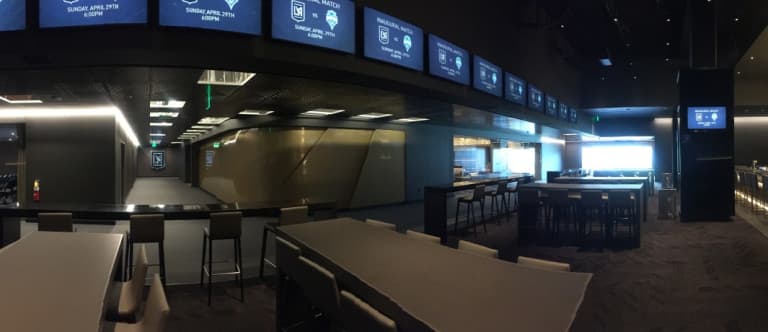
A shot of the players tunnel | photo by Alex Dwyer
Arenas across the world have redesigned the “tunnel.” The path players walk from the locker room to the field can be considered the most important ground athletes cover that’s not an actual playing surface, and LAFC’s take on the tunnel underlines that fact.
With another illuminated art-deco crest glowing behind them, players will march down a tunnel blacked out on one side, gold on the other, where owners and certain ticket holders are able to wish players luck as the enter the field in an unobstructed, wide-open space.
Though a private tunnel exists for players who are sent off or require treatment, the starting 11s will be fully throttled by the time their feet touch the stadium’s Bermuda grass.
Pool party vibes
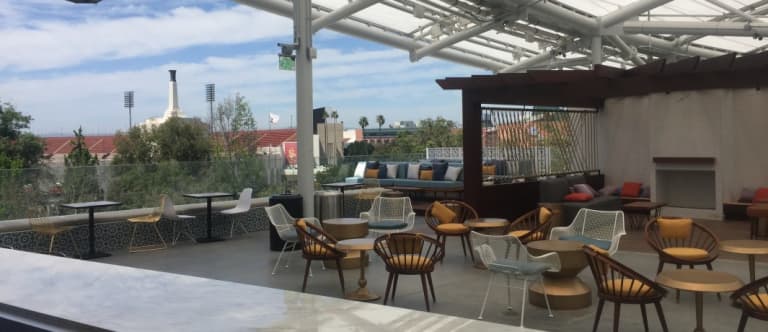
Banc of California Stadium's Sunset Deck | photo by Alex Dwyer
Images of a Los Angeles summer might include crashing waves, breezy palms and burning sands. Outside the beach neighborhoods though, those dreamy ideals have transitioned onto the rooftops that dot the city's urban interior. Banc of California Stadium’s Sunset Deck is of this mold.
Ping pong tables, shuffleboard and a water feature — think a knee-deep fountain where match-goers might soak their feet — create a vibe not unlike what one would imagine the best Coachella VIP areas offer. The indoor/outdoor space is a full-blown day-club, with mosaic tiles, a fireplace and cabana-like coverings with more cleverly designed seats and tables than I have room to describe.
Topping it off is the view to the west, where the California state flag peeks out above the nearby Los Angeles Memorial Coliseum right where the sun will drop when it retires for LAFC’s evening matches.
Sacred ground
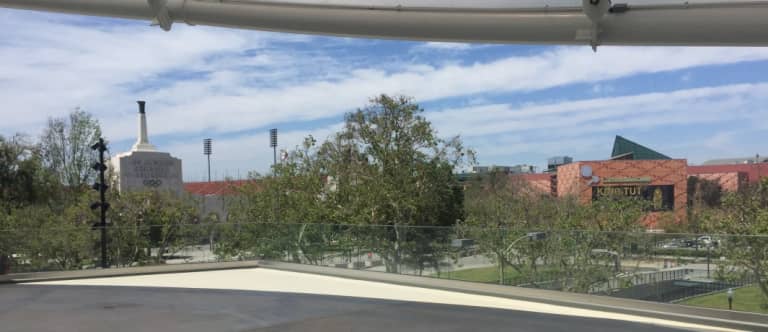
A look out at Exposition Park | photo by Alex Dwyer
It’s hard to overstate the historical significance of Exposition Park. Famous for museums (Natural History Museum, California Science Center, California African-American Museum, and forthcoming Lucas Museum of Narrative Art) events (John F. Kennedy received the presidential nomination in 1960 and musicians from Michael Jackson to Bruce Springsteen to Migos — have performed on the grounds over the years) and sports (a home to the Dodgers, Chargers, Rams, Lakers, Clippers, and Kings, as well as both basketball and football programs of UCLA and USC, to say nothing of hosting the 1932, 1984, and forthcoming 2028 Summer Olympics), Banc of California Stadium fits right in.
And from the 2-2 draw in a 1966 World Cup qualifier between Mexico and the United States to the 1967 United Soccer Association final where the LA Wolves defeated the Washington Whips in one of the first nation-wide contested professional leagues in the country, Expo Park also boasts over five decades soccer history. That includes the storied LA Aztecs of the 1970s and 80s, who called both the Coliseum and the Sports Arena home (for indoor). LAFC’s Carlos Vela even scored his first-ever goal for Mexico at Exposition Park’s LA Coliseum in a 2007 friendly against Guatemala.
The location of the stadium on a patch of land with such weighty history is perhaps its most significant feature. Now it’s simply up to the club to make its own impression on that sacred soil.












